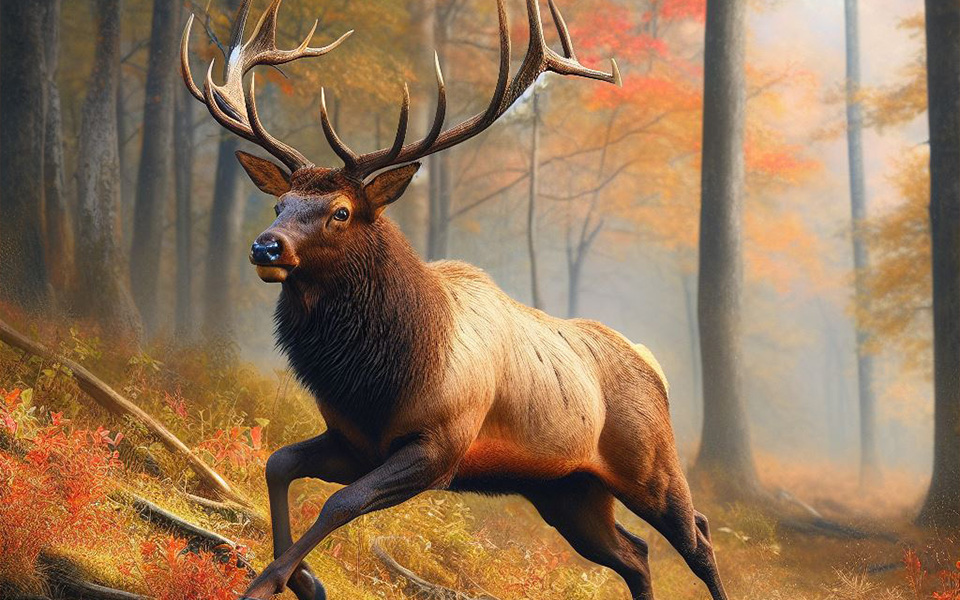Elk, a type of deer found in North America, are known for their majestic characteristics and impressive speed. In this article, we will explore the incredible speed at which elk can run, providing insight into their locomotion capabilities. From their running speed and agility to the factors that impact their speed, we will delve into the world of these fascinating creatures.
Key Takeaways:
- Elk are known for their impressive speed and agility.
- The maximum speed of an elk can reach an astonishing 45 miles per hour.
- Various factors, such as environmental conditions, can impact elk’s running capabilities.
- Elk are remarkable endurance runners, capable of sustaining their pace over long distances.
- Elk’s speed is crucial in mating season and defensive situations.
Table of Contents
Understanding Elk Running Speed and Agility
Elk are known for their impressive running capabilities, which are thanks to their physical characteristics and adaptations. Their long legs and powerful muscles allow them to move quickly across various terrains.
The average running speed of an elk is around 25 miles per hour, while their sprinting ability can reach up to 45 miles per hour. This locomotion speed allows them to outpace most predators and also cover large distances in search of food and water.
One of the key factors contributing to elk’s running capabilities is their agility. They can make quick and sudden turns when running, making it difficult for predators to catch them.
Elk also have unique adaptations that allow them to move effectively across different terrains. For example, their hooves are designed to provide excellent grip on uneven surfaces, while their muscular bodies enable them to move swiftly through dense vegetation.
Overall, elk running capabilities and speed are a marvel of nature, allowing them to thrive in a variety of habitats and outmaneuver predators.
Factors Affecting Elk Speed
Elk are known for their impressive speed and agility, but several factors can affect their movement speed. Let’s take a closer look at some of these factors:
| Factors | Description |
|---|---|
| Size and Strength | The size and strength of an elk can directly impact its speed. Larger, stronger elk tend to be faster than smaller ones. |
| Terrain | The type of terrain an elk is running on can significantly impact its movement speed. Elk can run faster on flat ground compared to rough and uneven terrain such as mountains. |
| Weather Conditions | Extreme weather conditions such as snow, rain, or high winds can affect the speed at which elk can run. Elk may not be able to run as fast in these situations, making them more vulnerable to predators. |
| Age and Health | Older or sick elk may not be as fast as younger, healthier ones due to decreased muscle mass and reduced cardiovascular function. |
Overall, elk can run at impressive speeds, but several factors must be considered to determine their overall movement speed.
The Fastest Elk Speeds on Record

Elk are impressive runners, and some of the fastest speeds ever recorded for these creatures are truly remarkable. While the average running speed of an elk may be around 40 mph, some have been known to reach speeds of up to 45 mph.
In fact, according to a study conducted by the University of Montana, the fastest elk speed ever recorded was a whopping 60 mph. This incredible sprinting speed was achieved by a bull elk during a chase by a predator.
| Elk Speed Record Holders | Speed Achieved |
|---|---|
| Bull Elk | 60 mph |
| Adult Cow Elk | 45 mph |
While it’s important to note that not all elk can reach these incredible speeds, it’s still amazing to see what these creatures are capable of when they’re in full sprint mode.
Impressive Sprinting Abilities of Elk
Elk’s sprinting abilities are truly impressive and are a result of their physical characteristics and adaptations. Their long legs and powerful muscles allow them to move quickly and efficiently, while their hooves serve as excellent shock absorbers, enabling them to run on a variety of terrains.
In addition, the cardiovascular system of elk is well adapted for sprinting. The heart of an elk can pump up to 20 liters of blood per minute, providing adequate oxygenation to the muscles responsible for running.
All of these factors contribute to the impressive sprinting abilities of elk and showcase their incredible speed and agility.
Elk Running vs. Galloping
Elk have two primary methods of locomotion: running and galloping. Running is characterized by a pace in which all four legs remain on the ground while galloping is defined by a series of jumps or leaps.
The running pace of elk is typically slower than their galloping speed, with an average pace of around 15 miles per hour (24 kilometers per hour). However, when in danger or pursued by a predator, elk can reach speeds of up to 45 miles per hour (72 kilometers per hour) in short bursts.
Elk Running Pace
When elk run, they use a gait known as “Flying Pace.” This gait involves a “bounding” motion in which all four legs leave the ground simultaneously. During this motion, the elk’s body moves forward and upward, allowing for a more energy-efficient gait.
Elk Galloping Speed
When elk gallop, they use a gait known as “Transverse Gallop.” During this gait, the elk’s front and hind legs on the same side move together in unison. This enables the elk to cover more ground with each stride, allowing for greater speeds.
Despite their ability to gallop at high speeds, elk typically only use this gait when running from danger or when chasing a potential mate during mating season.
Elk Speed in Relation to Other Animals
Elk are impressive runners, but how do they compare to other animals in the wild? When it comes to land animals, elk are among the fastest ungulates, or hooved animals. On average, elk can run at speeds of up to 45 miles per hour, which is faster than antelopes and springboks but not as fast as pronghorns, which can reach speeds of up to 60 miles per hour.
Elk are also slower than some predators that hunt them, such as grey wolves, which can run at speeds of up to 55 miles per hour. However, elk can sustain their speed over long distances, giving them an advantage when it comes to endurance.
Elk Running Capability in Different Habitats
Elk are known to inhabit various habitats across the world, including forests, mountains, and grasslands, each with its unique terrain and environmental conditions. These habitats, in turn, affect the running capabilities of elk, and they adapt to different terrains in various ways.
In mountainous regions, elk use their strong legs and endurance to run up and down uneven slopes and rugged landscapes. They have adapted to their environment by having smaller bodies that allow for more nimble movements. Compared to their counterparts in the plains, elk in the mountains are slightly slower but have better endurance. Elk can also leap over fallen trees, gullies, and ravines to avoid predators or navigate their territory during migration.
In the grasslands, elk thrive, and they are known to run at high speeds across vast distances. With flat terrain, elk can reach incredible speeds, sometimes up to 45mph, to outrun predators or herd. They use their long legs, powerful shoulders, and large lungs to cover long distances and maintain their pace.
Forested habitats have their challenges, including limited visibility, tight spaces, and obstacles. Elk adapt to these environments by using their agility to maneuver through the trees and underbrush. In the dense forest, elk rely more on maneuvering and change of direction rather than speed to evade predators and find food.
Their large size, adaptive behavior, and powerful muscles enable them to withstand rough and slippery terrains.
Elk Running Capability in Different Habitats Table:
| Habitat | Running Capability |
|---|---|
| Mountains | Adapted for more nimble movements but slightly slower than on the plains; greater endurance for rugged terrain. |
| Grasslands | Can reach speeds of up to 45 mph, covering long distances with powerful running capabilities across flat terrain. |
| Forests | Greater agility is required to navigate through dense trees and underbrush, less emphasis on speed and greater emphasis on maneuvering skills to evade predators. |
Elk Sprinting in Defensive Situations
Elk are known for their impressive sprinting abilities, and they often use this talent to escape from predators and other threats. These creatures can run at speeds of up to 45 miles per hour, making them a formidable opponent for any predator.
When elk sense danger, they may take off at full speed to get away from the threat. Their powerful legs and muscular build allow them to accelerate quickly, allowing them to quickly put distance between themselves and the danger.
Elk are also known for their agility, which allows them to quickly change direction and evade predators. They may run in a zigzag pattern or make sudden turns to avoid capture, making them a challenging target for predators.
During these defensive sprints, elk can cover a significant distance. While they cannot maintain their top speed for long periods of time, they can continue to run at a moderate pace for several miles if necessary.
Elk are incredibly resilient creatures, and their sprinting abilities play a significant role in their survival. Whether they are facing a predator or any other danger, their running capabilities allow them to escape and live another day.
Elk Speed During Mating Season
During breeding season, elk use their running capabilities to compete for mates. Male elk, also known as bulls, engage in fierce battles to establish dominance and attract females. These battles involve sprinting and charging at each other, which requires immense speed and agility.
Elk running capability during mating season is crucial for their survival as individuals and as a species. The ability to outrun rivals can mean the difference between successfully mating or being left out of the gene pool and going extinct.
Elk Sprinting Ability
The sprinting ability of elk is an important component of their running capability during mating season. Bulls attempt to run at high speeds to avoid being overtaken by rivals and to catch up to receptive females.
When running at high speeds, elk must be able to navigate through rough terrain while maintaining their balance and control. This requires the use of their strong legs and muscular bodies, which contribute to their impressive sprinting ability.
Elk must be able to quickly change direction and dodge obstacles to avoid injury and maintain their momentum during these intense mating season battles. Their agile movements are a testament to their exceptional running capability.
Elk’s running capability during mating season is a crucial aspect of their survival and reproductive success. Their impressive sprinting ability and agility enable them to navigate through rough terrain and outcompete rivals for mating opportunities.
Environmental Factors Impacting Elk Speed
Elk are known for their remarkable running capabilities, but their speed can be affected by various environmental factors.
- Weather Conditions: Extreme weather conditions such as heavy rain or snow can significantly impact the speed at which elk can run. Slippery and muddy terrains may also affect their running pace.
- Terrain: The terrain on which elk run can greatly affect their speed. Steep uphill or downhill terrain can slow them down, while flat and even terrain can help them achieve greater speeds.
- Altitude: Elk living in high altitudes may have lower oxygen levels, which can affect their endurance and speed.
- Food Availability: The availability of food can also affect elk speed, as malnourished elk may not have the energy to run as fast or as far as healthy elk.
Elk are adaptable creatures that can adjust their running capabilities based on the environment they inhabit. However, environmental factors can still have a significant impact on their running pace and capability.
The Incredible Endurance of Elk
Elk are not only known for their impressive sprinting speeds but also their remarkable endurance. These creatures can sustain their running pace for great distances, making them exceptional long-distance runners in the animal kingdom.
Their incredible endurance can be attributed to their unique physical characteristics, which allow them to efficiently use oxygen while running. Elk have large lungs, heart, and blood vessels, which work together to deliver oxygen to their muscles and remove waste products efficiently.
They have a unique gait that minimizes energy expenditure, allowing them to run longer distances. They use a four-beat gait, which involves having one foot on the ground at all times, reducing the impact of their stride and conserving energy.
Elk’s endurance is also impacted by their body mass and overall fitness. Studies have shown that heavier and fitter elk can run for longer distances at higher speeds than lighter and less fit elk.
Their endurance is a testament to their incredible physical adaptation and fitness, making them one of the most impressive runners in the animal kingdom.
Unraveling the Mystery of Elk Speed
After exploring the various facets of elk running capability, we’ve gained a deeper understanding of the incredible speed and agility of these creatures. From their impressive sprinting velocity to their endurance over long distances, elk have proved to be excellent runners in various terrains.
So, how quick can an elk run? The running speed of elk varies depending on several factors such as their size, strength, and environmental conditions. However, on average, adult elk can run at a speed of 40 miles per hour.
The Elk Sprinting Velocity
Elk also have impressive sprinting abilities, as evidenced by the record speeds they have achieved. The fastest elk speed ever recorded is around 45 miles per hour. This remarkable sprinting velocity is vital during mating season when male elks compete fiercely with one another to attract female mates.
Elk Running Capability in Various Habitats
Elk’s running pace is also impacted by the habitat they are in. In the mountains, for example, elk have to navigate steep terrains and rugged landscapes, which requires them to be more agile and adapt their speed accordingly. In comparison, in the plains, elk can run faster due to the more open space.
Elk’s Endurance Over Long Distances
One of the most impressive aspects of elk running capability is their endurance over long distances. Even though elk can achieve remarkable speeds, they can also maintain their running pace over longer distances, thanks to their cardiovascular system. Elk have bigger hearts than other mammals of their size, which allows them to sustain their running speed for more extended periods.
In conclusion, elk’s running capability showcases their impressive speed and agility, making them one of the most awe-inspiring creatures in nature. From their sprinting velocities to their endurance over long distances, elk have proved to be excellent runners in various habitats.
FAQ
How fast can an elk run?
Elk can run at speeds of up to 45 miles per hour.
What is the maximum speed of an elk?
The maximum speed recorded for an elk is around 45 miles per hour.
What is the top speed of an elk?
The top speed of an elk is approximately 45 miles per hour.
How does elk running speed compare to other animals?
Elk are known to be fast runners, but their speed is relatively slower compared to animals like cheetahs and pronghorns.
What factors affect elk speed?
Factors such as the elk’s size, strength, and the environmental conditions can affect their overall running speed.
Can elk run faster in different habitats?
Yes, elk are capable of adapting their running capabilities to various habitats, allowing them to navigate through mountains, plains, and other terrains.
How do elk use their running speed during mating season?
Elk’s running capabilities play a crucial role in the competitive nature of mating rituals, allowing them to chase rivals and establish dominance.
Do elk sprint in defensive situations?
Yes, elk can sprint at high speeds when faced with threats or predators as a means of protecting themselves and their herds.
How does the environment impact elk speed?
Environmental factors such as weather conditions and terrain can affect the speed at which elk can run.
Can elk sustain their running speed over long distances?
Yes, elk have remarkable endurance and can maintain their running speeds over long distances, thanks to their cardiovascular systems.
What is the mystery behind elk speed?
Elk’s speed and agility are fascinating aspects of their nature, showcasing their impressive running capabilities in various habitats and during different situations.


